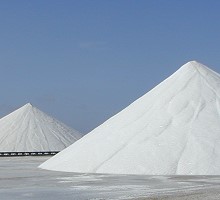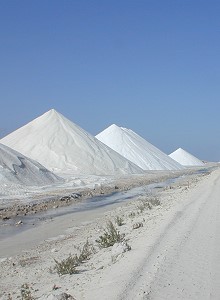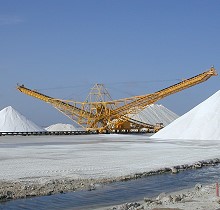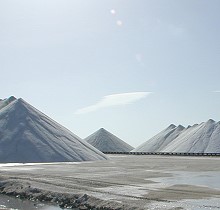|
|
Salt Pans
Cargill Salt Bonaire N.V. is a division of Cargill, Incorporated (Cargill).
The Company took over the operation of the solar salt worksin Bonaire in 1997, and now
Cargill Salt Boanire produces the mountains of white salt crystals that are solt worldwide.
The salt made at Cargill Salt Bonaire is a natural product of sea water, sunshine and wind.
Sea water is pumped into coondenser ponds to sit until full saturiation is reached. The brine
is then pumped into crystallizers where it remains under constant evaporation until crystallized
to the point that it can be harvested. Each pond is harvested about once a year. The crystals are
washed then dried for several months. Finally, at 2000 tons a hour, it is loaded by conceyor belt
into ships.
The harvesting of salt has been a major industry on Bonaire for over 350 years. It was a laborious
task first done by slaves, and after abolition of slavery, by laborers from the surrounding villages.
Over the ensuing years, due to high tariffs and little capital investment, the industry fell on hard
times until it was revitalized an modernized in 1963. Throughout the centuries, salt has been an
important trade commodity. In early Roman days, the soldiers were paid their wages in salt - salarium-
hence the English work for pay became salary. Salt was no less important to the sixteenth century Dutch-
they had cornered the European market with salt that came mostly from Portugal.
Arround 1550, Portugal came under the rule of Spain, a country with whom the Netherlands was already at
war. Faced with the loss of their salt source, the Dutch sailors began to explore the Caribbean in search
of a new supply. One of the first places they explored was Punta de Araya, Venezuela, on the South American
coast. A Salt industry soon developed there, and the area became major supply center. The Dutch sailors
continued to explore the Caribbean islands that lay off the South American continent, Bonaire being one
of them.
In 1623, the first Dutch ships landed on Bonaire, and in 1636 the Dutch occupied the islands and began
to develop the salt, dyewood and mutton industries. Possesion of the island changed back and forth between
the European powers until 1816, when the dutch reclaimed it for the final time. Cargill, Incorporated began
in 1865 when W.W. Cargill opened his first grain flat house - a type of storage warehouse that preceded
country grain elevators - in Conover, Iowa. It was conveniently located at the terminus of the McGregor and
western Railroad.
From this humble beginning, the Company has grown to one of unimaginable proportions in it's depth ans scope
of businesses. Cargill markets, progresses an distributes food, agricultural products, financial and indistrial
products in 65 countries.
It has business activities in another 130 countries. The company has 80,000 employees spread over 1,000
locations. It may come as a surprise to most visitors that the majority of the salt that is produces on
Bonaire is used in water softeners. The exeption to this market for Bonaire salt occured over the past few
winters when the Northeast USA suffered some of the worst weather on record. Salt containers ships were
lined up at the pier, loading their valuable cargo, which was used to help make life easier to navigate
the slippery road conditions for our US neighbors.
|




|
|